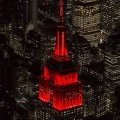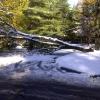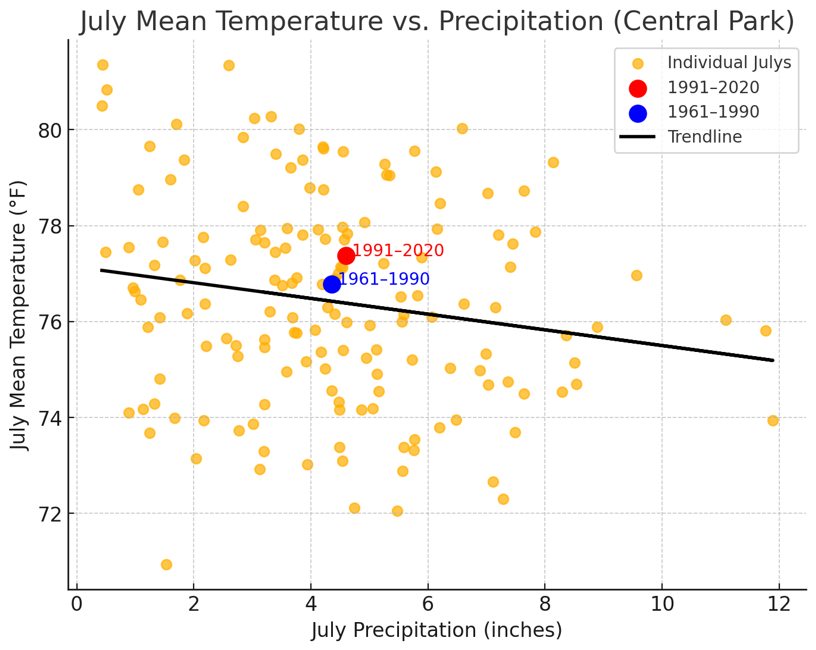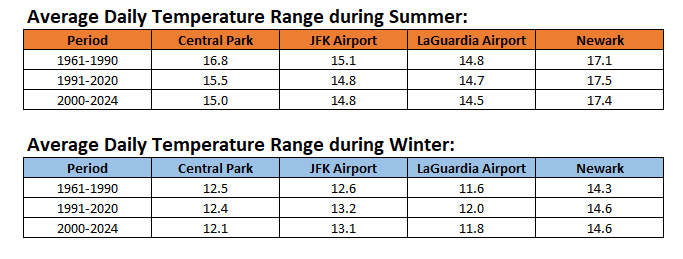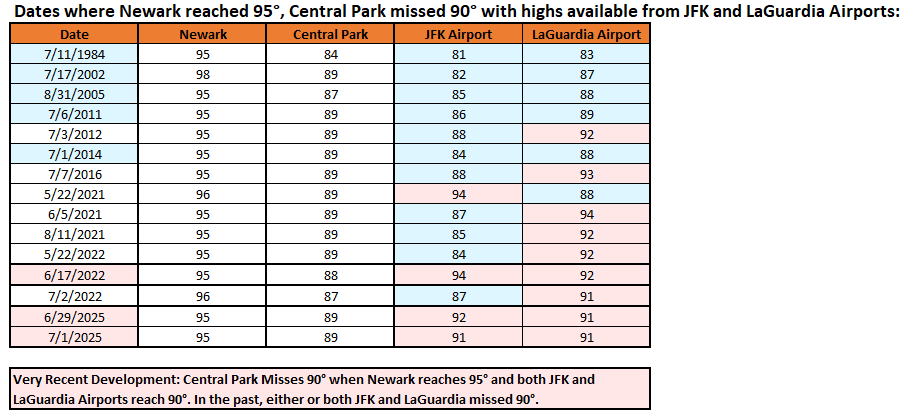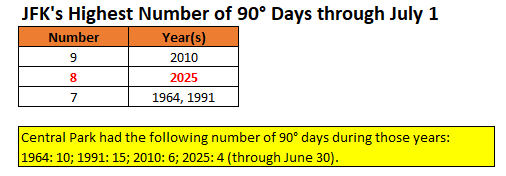-
Posts
21,781 -
Joined
About donsutherland1

Contact Methods
-
Website URL
http://wintercenter.homestead.com/photoindex.html
Profile Information
-
Four Letter Airport Code For Weather Obs (Such as KDCA)
KNYC
-
Gender
Male
-
Location:
New York
Recent Profile Visitors
The recent visitors block is disabled and is not being shown to other users.
-

July 2025 Discussion-OBS - seasonable summer variability
donsutherland1 replied to wdrag's topic in New York City Metro
Generally warm weather will prevail through Saturday. New York City will see highs in the middle to perhaps upper 80s during this stretch. Parts of the region could experience some thunderstorms tomorrow afternoon or evening. After that, the next rainfall will likely occur during a frontal passage early next week. Excessive heat does not appear likely to return through at least the first week of July. There remains some potential for a shot of more significant heat during the July 6-8 period. The worst of the heat, should it develop, will likely occur away from the coastal plain. The ENSO Region 1+2 anomaly was +1.0°C and the Region 3.4 anomaly was 0.2°C for the week centered around June 18. For the past six weeks, the ENSO Region 1+2 anomaly has averaged +0.47°C and the ENSO Region 3.4 anomaly has averaged -0.03°C. Neutral ENSO conditions will likely continue through at least late summer. The SOI was +7.32 today. The preliminary Arctic Oscillation (AO) was +1.176 today. -

July 2025 Discussion-OBS - seasonable summer variability
donsutherland1 replied to wdrag's topic in New York City Metro
July Mean Temperatures and Precipitation at Central Park: In general, drier outcomes are correlated with hotter outcomes. However, 1991-2020 has become both warmer and wetter than the 1961-1990 base period. -

July 2025 Discussion-OBS - seasonable summer variability
donsutherland1 replied to wdrag's topic in New York City Metro
Yes. It should have easily beaten the record (46 +/- 5 days using the pre-2000 summer regression equation). -

July 2025 Discussion-OBS - seasonable summer variability
donsutherland1 replied to wdrag's topic in New York City Metro
Yes, all things being equal, a wetter climate can temper heatwave intensity and duration. -

July 2025 Discussion-OBS - seasonable summer variability
donsutherland1 replied to wdrag's topic in New York City Metro
That's something the data can't really illustrate. But one would expect similar trends in the nearby locations as one is seeing at Central Park if synoptic developments were largely responsible. Instead, Central Park has been decoupling from the nearby locations when it comes to high temperatures. Indeed, absent the trees, Central Park would likely have had two 100° days so far, including a June record 102° high (pre-2000 regression equation). -

July 2025 Discussion-OBS - seasonable summer variability
donsutherland1 replied to wdrag's topic in New York City Metro
Wetter summers but not more frequent rainfall. But the decoupling between Central Park, JFK, LaGuardia, and Newark, which are experiencing similar rainfall trends suggests its Central Park's local environment that is playing the larger role in somewhat reduced high temperatures. -

July 2025 Discussion-OBS - seasonable summer variability
donsutherland1 replied to wdrag's topic in New York City Metro
The average number of days with 0.01" or more rainfall per week during the summer hasn't really changed too much. The amount of rainfall has increased and was at its highest 30-year average for the 30-year period ending in 2020. If one goes beyond 2020, the most recent 30-year period (1995-2024) averaged 2.42 days per week with 0.01" or more rain during the summer and average total summer rainfall of 13.99". -

July 2025 Discussion-OBS - seasonable summer variability
donsutherland1 replied to wdrag's topic in New York City Metro
The ranges haven't changed too much, though the summer range in Central Park has fallen a bit more than elsewhere (possibly due to the trees’ impact on highs as summer highs have decoupled from those at the surrounding sites most prominently seen with 90°/100° outcomes). But even during the summer, the coefficient of determination has barely moved (0.84 during 1961-1990 to 0.83 at present) when Central Park's range is constructed relative to those of JFK, LaGuardia, and Newark. This suggests that larger forces are responsible for the temperature range than the trees. -
A total disgrace and another great leap backward.
-

July 2025 Discussion-OBS - seasonable summer variability
donsutherland1 replied to wdrag's topic in New York City Metro
These developments provide good examples of how the dense foliage has changed the relationship of Central Park relative to the City's other locations and Newark. The problem is cited in the NOAA's inventory of stations. Unfortunately, the problem is not addressed. Thus, Central Park becomes less representative of the City's actual climate and, instead, an experiment that demonstrates the cooling impact of trees. -

July 2025 Discussion-OBS - seasonable summer variability
donsutherland1 replied to wdrag's topic in New York City Metro
Much of the region saw temperatures again reach 90° or above. Parts of the region will experience some heavy thunderstorms this evening and tonight. Generally warm weather will prevail through Saturday. New York City will see highs in the middle to perhaps upper 80s during this stretch. Excessive heat does not appear likely to return through at least the first week of July. However, there is somewhat less certainty than yesterday. There remains some potential for a shot of more significant heat during the July 6-8 period. The ENSO Region 1+2 anomaly was +1.0°C and the Region 3.4 anomaly was 0.2°C for the week centered around June 18. For the past six weeks, the ENSO Region 1+2 anomaly has averaged +0.47°C and the ENSO Region 3.4 anomaly has averaged -0.03°C. Neutral ENSO conditions will likely continue through at least late summer. The SOI was +2.65 today. The preliminary Arctic Oscillation (AO) was +1.127 today. -

July 2025 Discussion-OBS - seasonable summer variability
donsutherland1 replied to wdrag's topic in New York City Metro
Today became just the third day during the common recordkeeping period where Newark reached 95°, JFK and LaGuardia both reached 90°, but Central Park fell short of 90°. 2025 is the first year with two such days. -

July 2025 Discussion-OBS - seasonable summer variability
donsutherland1 replied to wdrag's topic in New York City Metro
So far, Central Park's high today is 88°. Newark has reached 95°. Should Central Park fail to reach 90°, Central Park would record its shortest interval on record between dates where Newark reached 95° or above while Central Park failed to reach 90°. On June 29, 2025, Newark topped out at 95°, while New York City (Central Park) reached 89°. The existing shortest interval is 14 days from May 22, 2021 to June 5, 2021. JFK Airport and LaGuardia Airport have both reached 91° so far today. -

July 2025 Discussion-OBS - seasonable summer variability
donsutherland1 replied to wdrag's topic in New York City Metro
-

July 2025 Discussion-OBS - seasonable summer variability
donsutherland1 replied to wdrag's topic in New York City Metro
July 1, 1911 saw 2.68" of rain in Phoenix (high: 79°) and July 2, 1911 saw an additional 2.81" of rain (high: 82°). The July 2 figure remains the highest July daily amount on record and the two-day figure of 5.49" is the highest two-day figure on record for any two-day period in Phoenix.


